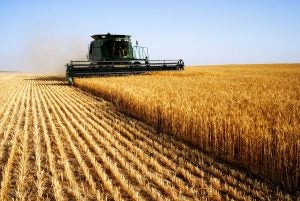Do volunteer plants in re-crop wheat act as weeds? How about volunteer corn in re-crop corn? A study conducted by researchers located at the Columbia Basin Agricultural Research Center answers the question for wheat. Led by Stewart Wuest of the U.S. Department of Agriculture’s Agricultural Research Service and collaborating researchers from Oregon State University, the study was published in Agronomy Journal, “Is volunteer wheat an economic weed in annual wheat production?”
The research was conducted in three fields in the inland Pacific Northwest during 2015 and 2016. When winter wheat follows winter or spring wheat, control of volunteer wheat can be a problem because the Pacific Northwest autumn rainfall is often too sparse to adequately geminate the seeds that fail to separate from the straw and end up scattered behind the combine by the straw spreader, or end up concentrated in the chaff row if no spreader is used. Farmers are often forced to “seed in the dust” and ignore the volunteer that is bound to come with the seeded crop when it finally rains.
Such plants obviously compete with the seeded crop for nutrients and moisture, but since they contribute to yield, is the competition serious? Wuest and his colleagues attempt to answer that question.
Field 1, a research plot located approximately nine miles Northeast of Pendleton, Oregon, had been in continuous no-till wheat for 18 years. The soil was Walla Walla silt loam with annual precipitation of 16.5 inches. Field 2 was a research field at the same location as Field 1. It was in its second year of annual winter wheat after many years of a wheat-fallow rotation. Field 3 was a commercial field located 2.8 miles Northeast of Dixie, Washington. It had been in a fall wheat spring wheat rotation for 10 years. Soil was a Palouse silt loam; annual precipitation was 21 inches. In this field, the seeded variety was hard red winter variety Jebb and the volunteer was dark northern spring variety Kelso that had germinated in the fall and survived the winter.
Data was collected from Fields 1 and 2 in 2015 and 2016. Field 3 was only sampled in 2016. Small plots were hand-harvested from all fields at ground level, bagged and taken to the laboratory. In fields 1 and 2 the presence of awns or awnless facilitated the separation of volunteer from seeded varieties. In field 3, both varieties were awned, so between-row plants were assumed volunteer and bagged separate from in-row plants. After separation, heads were counted, threshed, weighed and converted to yield per acre.

Quoting from the paper, “The average productivity per head of seeded wheat was higher than volunteer wheat in all fields. … The data show that grain yield from volunteer wheat contributed to total yield, but volunteer reduced overall yield because it was not as productive as seeded wheat. … When the yield supplied by the volunteer wheat was not considered, an average density of 120 heads (per square meter) reduced the yield of seeded wheat an average of 13%. … When total wheat yield was considered (seeded + volunteer), yield reduction due to volunteer wheat was not observed. … However, the results indicate an average yield increase of 10.8% if volunteer wheat were not present.”
The authors conclude, “Volunteer wheat may cause less yield loss than other winter annual weeds because of its contribution to yield. However a 10% yield loss is significant and practices to minimize volunteer wheat in wheat fields are recommended.”
Continuous corn can experience serious yield losses from volunteer corn. Depending on the hybrid used, volunteers may be resistant to roundup. Shallow tillage in the fall that buries the seed can result in the biggest problem because a covering of soil protects the seed from weathering and rodents. Spring tillage and non-Roundup herbicides can be quite effective.
There will always be escapes, though, and unlike volunteer wheat, their contribution to yield is usually minimal, while reducing yield of seeded plants around them through competition for resources. Volunteer plants from the preceding year’s hybrid may produce plants with unusual characteristics such as small or unusable ears. Most likely they will not pollinate with the rest of the plants so cobs may be nearly devoid of kernels. With heavy, untreated infestations, volunteers can cause yield reductions up to 30 percent.
A few days delay in emergence of wheat plants is not likely to noticeably affect yield. But uneven emergence in corn can mean pollination problems and therefore significant yield reductions. An article in Farm Progress points out that germination is best if moisture is about 32 percent, most likely to occur at a depth of 2 to 2.5 inches. Seeds sitting in lesser moisture will germinate more slowly.
Jack DeWitt is a farmer-agronomist with farming experience that spans the decades since the end of horse farming to the age of GPS and precision farming. He recounts all and predicts how we can have a future world with abundant food in his book “World Food Unlimited.” A version of this article was republished from Agri-Times Northwest with permission.



